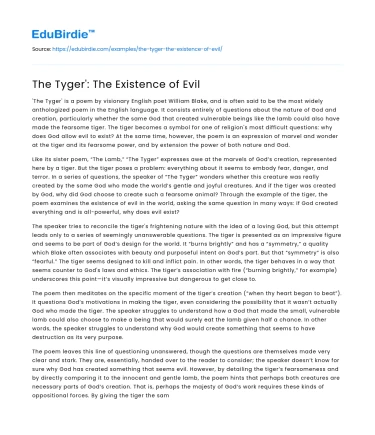'The Tyger' is a poem by visionary English poet William Blake, and is often said to be the most widely anthologized poem in the English language. It consists entirely of questions about the nature of God and creation, particularly whether the same God that created vulnerable beings like the lamb could also have made the fearsome tiger. The tiger becomes a symbol for one of religion's most difficult questions: why does God allow evil to exist? At the same time, however, the poem is an expression of marvel and wonder at the tiger and its fearsome power, and by extension the power of both nature and God.
Like its sister poem, “The Lamb,” “The Tyger” expresses awe at the marvels of God’s creation, represented here by a tiger. But the tiger poses a problem: everything about it seems to embody fear, danger, and terror. In a series of questions, the speaker of “The Tyger” wonders whether this creature was really created by the same God who made the world’s gentle and joyful creatures. And if the tiger was created by God, why did God choose to create such a fearsome animal? Through the example of the tiger, the poem examines the existence of evil in the world, asking the same question in many ways: if God created everything and is all-powerful, why does evil exist?
Save your time!
We can take care of your essay
- Proper editing and formatting
- Free revision, title page, and bibliography
- Flexible prices and money-back guarantee
The speaker tries to reconcile the tiger's frightening nature with the idea of a loving God, but this attempt leads only to a series of seemingly unanswerable questions. The tiger is presented as an impressive figure and seems to be part of God’s design for the world. It “burns brightly” and has a “symmetry,” a quality which Blake often associates with beauty and purposeful intent on God’s part. But that “symmetry” is also “fearful.” The tiger seems designed to kill and inflict pain. In other words, the tiger behaves in a way that seems counter to God's laws and ethics. The tiger’s association with fire (“burning brightly,” for example) underscores this point—it’s visually impressive but dangerous to get close to.
The poem then meditates on the specific moment of the tiger’s creation (“when thy heart began to beat”). It questions God’s motivations in making the tiger, even considering the possibility that it wasn’t actually God who made the tiger. The speaker struggles to understand how a God that made the small, vulnerable lamb could also choose to make a being that would surely eat the lamb given half a chance. In other words, the speaker struggles to understand why God would create something that seems to have destruction as its very purpose.
The poem leaves this line of questioning unanswered, though the questions are themselves made very clear and stark. They are, essentially, handed over to the reader to consider; the speaker doesn’t know for sure why God has created something that seems evil. However, by detailing the tiger’s fearsomeness and by directly comparing it to the innocent and gentle lamb, the poem hints that perhaps both creatures are necessary parts of God’s creation. That is, perhaps the majesty of God’s work requires these kinds of oppositional forces. By giving the tiger the same kind of consideration as the lamb, the speaker suggests that without fear and danger, there could be no love and joy.
Opposites run throughout Blake’s work—innocence and experience, the city and nature, childhood and adulthood—and so the tiger and the lamb can be seen as part of this pattern. In order for God to fully express his divinity, he has to create elements of the world that go beyond the understanding of humanity. God proves its power precisely because He acts in ways that humanity cannot fully comprehend.
The poem, then, is a deeply complex set of questions that have no easy answers. There is no doubt, though, that the poem wants its reader to consider the way in which the world seems to contain both good and evil—to acknowledge these contradictory forces and question why they exist, even though the answers may never be clear.






 Stuck on your essay?
Stuck on your essay?

